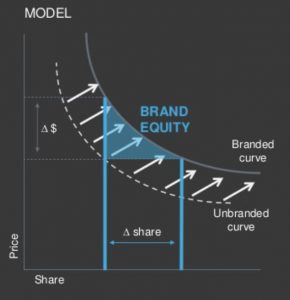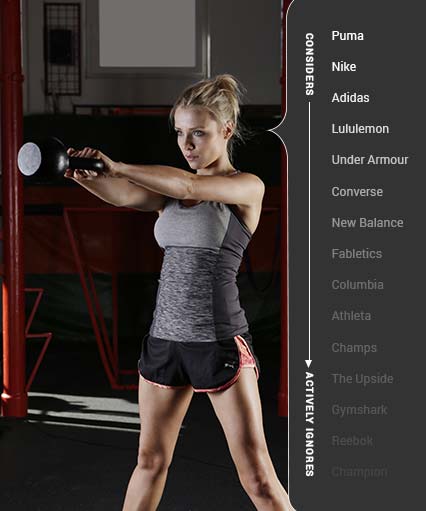Branding influences people desire to purchase, share, donate, etc. Why is this the case? And how can we tap into that power?
I have been studying branding for a decade and a half, and read a dozen books to answer two undying questions: what makes branding work? Moreover, how can I get people to care about my brands? I have never felt more confident about the answer then now.
What is the power of branding? The power of branding is its ability to influence behavior. We brand companies so they can build reputations. A brand with a good reputation elicits more purchases, advocacy, donations, shares, etc.
We give names, logos, taglines, and colors to organizations so that people can more easily assign reputations, attributes, and values in their mind. Subconsciously, they place the brand in their value system, which guides their next actions. If they can act to get something they value and they see the brand as helpful, then they will turn to the company.
For example, if someone wants to replace their car, they will look for opportunities. If they value sustainability, then they will see Tesla cars, ads, and showrooms everywhere, and they will be filtering out all the options and brands that they don’t associate with sustainability: Jeep, Ferarri, Ram, etc. If they value ruggedness or performance, they will see the landscape entirely differently.
The power of branding comes from deep, subconscious parts of our brain that developed many millennia ago. Branding is just how these ancient yet sophisticated neural systems work in today’s world.
Brand Effect
Branded products or services sell more at higher prices. They form their own market.
Organizations nearly universally understand that they need to brand themselves; they need to assign a name, logo, and foster some consistency around their communications. If every organization feels the need to do this, then the effect must be powerful.
The brand effect is the ability of reputations to influence people’s future behavior. For businesses, this means branded companies sell more at higher prices, but the power of a strong brand can also affect people’s desire to donate, share, participate, volunteer, file taxes, and many other desirable actions. People are more willing to associate with and help organizations that have a reputation, and names and logos help people keep track of those reputations.

In economic terms, a company’s brand is its influence on the demand curve; demand moves up and to the right, meaning customers would buy more and pay higher prices. The brand effect is interesting because companies should only be able to influence the supply curve, but we observe that companies with a strong brand move the demand curve.
For example, there is low demand for electric cars, but there is a high demand for Tesla’s electric cars. There is low demand for tablets, but there is a high demand for iPads. Successfully branded products seem to break from the economics of their market and form their own market.
So a brand is something that can be invested in through brand marketing and generates a return, like any business asset. The value that investment is called brand equity. The further a brand pushes that demand curve, the higher the brand equity. Apple currently has the highest brand value in the world.
Our Value Systems
Brands work because they can slot our individual value systems.
Branding works because of the human propensity to subconsciously gather attributes and build reputations. These standings help you filter information and choose your next actions.
Our ability subconscious reputation gathering evolved because it was crucial to the survival of our ancient ancestors. Remembering which berries were nutritious or what animal was a predator allowed our ancient ancestors to spot opportunities and avoid threats. We could parse the increasingly complex natural environment. Reputations are also critical for social species, like humans.
A value system if the filter of motivations and beliefs you put on the world in order to act. You may have heard of value system before in a religious or cultural context, such as the ‘Christian value system’ or ‘western values.’ This is the same context; our culture and our religion affect what we value and, in turn, how we act. However, our personality, social group, and past experiences also shape our values.

“[Y]ou can’t even look at the world without a value structure,” says Jordan Peterson, best selling author, and psychology at the University of Toronto, during this lecture. “It’s chaos if everything is equally unimportant, or equally important.”
To act, you need to know if one action is better than another. There is a nearly infinite number of things you can do. You act based on what you value.
Presumably, you are reading this article on a phone or tablet, which has a ton of apps you could be using. On the internet, there are nearly infinite pieces of content you could be reading. There are one hundred things you could be doing in your immediate environment: getting a cup of coffee, tidying your purse, talking with the person near to you, etc.
However, you aren’t doing any of those things, nor would you even contemplate doing any but a tiny fraction of possible behaviors. Why? Because you value what you are currently doing or the fruits of those labors. You are perpetually trying to better your standing; you are always assuming that an outcome of an action is better than what you have at the current moment. It’s the human condition.
Values can change based on your mood or physical state. When you are hungry, you see the world through the eyes of a hungry person, and you are more likely to see restaurants or ads for food. When you are feeling jealous or insecure, you notice ads for makeup or luxury cars. Facebook offers to target advertisements for brands based on mood.
Brands Interact and Slot Into Our Value System
Our value system affects the brands that we notice.

“[T]he average person sees between 400 and 5000 brand messages a day,” Omar Akhtar, an analyst at Prophet said in this post, “which means that 90% of everything a brand communicates is bound to have zero impact.”
So what is the difference between the branded messages that get noticed and ignored? Our individual value systems. If a brand offers something you value, you notice it’s messages. If a brand has proven its value or demonstrated its alignment with your personal values, then you notice it’s messages.
Let’s go through a few examples:
- People who value an active lifestyle are far more likely to interact with Nike, Adidas, Lululemon, or Fabletics.
- People who have had continuous positive experiences with Apple don’t even see messages from other phone or computer manufacturers.
- People who value environmental action see brands like Seventh Generation, Patagonia, and Method.
The Porsche and the Gucci Dress
A narrative example of a couple and what they each notice.
A middle-class couple is walking down an urban street. A bright white Porsche drives by them and the man, who is a car enthusiast, gets all excited.
“Wow,” exclaims the man. “That was the new Taycan. You don’t see that every day. Did you like it?”
“I didn’t notice…” the woman says, passively.
They continue walking down the street. After another woman in a bright pink dress passes by, the woman whispers in the man’s ear.
“That chick was wearing a Gucci belted dress coat,” she whispered. “Those things are really expensive. She must be a trust fund baby.”
“I didn’t notice…,” the man says.
This story rings true because we filter the brands we see and interact with based on our values. The man values sports cars and noticed them, and doesn’t care about dresses, so he ignores them — moreover, vice versa for the lady.
Value Hacking
How do you break through and into a person’s value structure?
So, the consumer’s brain is actively filtering out brands they don’t value, but new brands are getting noticed. Actually, once a brand breaks through into people’s value system, they experience breakout success with hockey stick growth curves.
How does that happen? Only a few ways: by removing a barrier to something people value, aligning your brand values with them, combining two values, framing your message in something they value, and talking directly to open people or early adopters.
1) Solve a previously unsolved problem for them.
Most name brands found their success from commercializing a new technology that solved a nagging problem for people. The explosive growth of a company that has a novel solution to a problem is what the angel investors and venture capital firms are banking on when they invest in technology startups, but innovations happen outside of silicon and software.
We wrote a case study on the success of DC Shoes. Ken Block and Damon Way, the founders of DC Shoes, had only mild success in the skateboard movement until they started combining the impact absorbing rubbers used in running shoes with the flat bottom sneakers that borders needed to perform tricks. The shock absorption reduced the injuries and aches of skateboarders feet, allowing them to stay out for longer, which they valued… a lot!
Note that this also works for non-profits. 4Ocean broke out because they found a donation model to clean up the oceans, which is a problem that people are just waking up to.
2) Align your brand values with the values of an under served group.
There are groups of people whom all share common values. These groups often rally around a brand because it speaks to their values or helps them identify with a group. You can attract an army of loyal patrons if you can align your brand’s values with the values of a group of people.
For example, there are a set of people who put a high value on being able to switch from activity to everyday living. It’s a very coastal Californian fantasy; do a 5k run at sunrise, towel off, and sit for your morning espresso and breakfast on a coffee shop patio.
Vuori authentically aligns with this market in both their messaging and products. They make athletic wear that looks casual. Their design ethic is: “built to move, and styled for life.”
The interest (and presumably sales) of Vuori are just exploding. They have doubled their brand equity every nine months for the last 2 ½ years.
3) Place your brand at the intersection of two values.
People are never one dimensional; they always have multiple values that drive them. Sometimes there is the opportunity to combine something a group of people values with another value.
For example, everyone values humor, and some people value staying informed regarding the news. The Daily Show became the first late-night show to break out in thirty years by injecting humor and the news.
The intersectional approach is the strategy we are using with our project brand, Nordeau. We know that some people highly value skiing and/or snowboarding, and looking / smelling / feeling good for apres-ski. We hope that we can gain a loyal base of skiers and boarders by serving them and aligning with their values, and then broaden own to the broader personal care market. You can read how we arrived at that strategy in the post: Our Lifestyle Brand Strategy.
4) Frame your brand’s message in something they already value.
If you cannot or are not willing to change your brand’s values, but you want people to notice your message, then you can frame your message in something that people value.
Advertising agencies are masters of this. They can take messages about insurance, toilet paper, or floor cleaner, and wrap it in humor, self-identity, or family values, and suddenly people listen.
You can also do this by context. Brands use conventions to get in front of a group of people with the same value. I worked with Warner Brothers on their booth for Fan Expo, Toronto’s biggest comic convention. The convention was an opportunity to frame the movies and TV series’ they distribute in a way that spoke to people who valued comic book storytelling and superheroes.
5) Target early adopters or creative people.
Some people are more likely to step out of their value systems and try new things. Marketers and technologist call these people “early adopters” but psychologists define these people as high on the “openness to experience” personality trait.
These people are typically highly creative, outgoing, and have liberal political views. You may consider trying to get in front of such people with ads, demonstrations, or trials of your product.
Conclusion
Work with people’s existing value, and your brand will break out.
The effect of branding is powerful, or nearly every company would not feel the need to have a name and a logo. The power of branding is to influence actions; a strong brand can lubricate the process of asking for purchases, likes, shares, donations, or whatever action a business desires.
The branding effect is powerful because it is subconscious. We evolved the ability to gather reputations. The reputations we have in our lower level brains allow us to filter the information from our environment and spot opportunities. We all filter out messages from brands we do not care about, and actively look for info from brands we do care about.
So how do we, brand builders, make sure our brand is on the list of what people care about? You have to work with what people already value.
We all value safety, family, social groups, status, freedom, self-expression, and self-actualization. However, individuals can have very different values; surfers value the ocean lifestyle, while Wall Street bankers value making money.
For your brand to break out, you need to find under-served groups and understand what they value. They either have trouble accessing what they value or doesn’t find brands that align with their values. Serve those people, and your brand will find success.

Leave a Reply